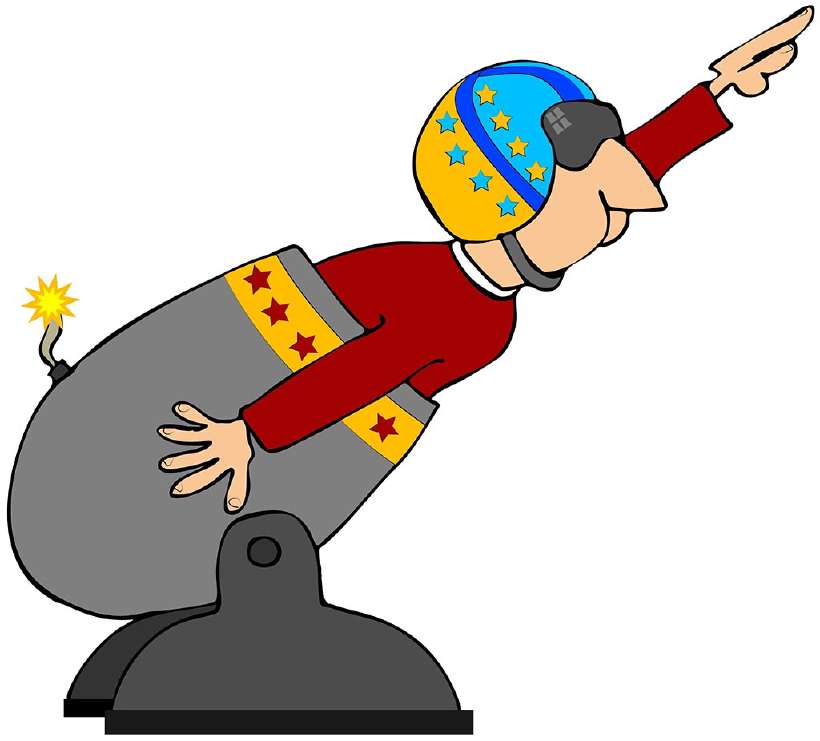How do Human Cannonballs Fly?
Home / Science for Kids / 5Ws & H For Kids / How do Human Cannonballs Fly?
Even been to a circus where they featured a human cannonball? A person enters a huge cannon and when the fuse is lit, he comes shooting out with a bang, flying in the air before landing on a net!
My god! I thought that was the most horrifying thing I had ever seen. What a crazy thing to do. How does he do it without being blown to pieces, I would wonder.
![How do Human Cannonballs Fly? [Illustration by Anup Singh]](/media/5wh-64_1_hufb457cf3c4a3b124b99bea079267766c_14970_820x0_resize_q60_box.gif)
Though scary, it was one of the most captivating items for me, and the hundreds of children and adults who would watch the circus item with their mouths open.
Then the questions came cannoning into our minds: how does the human cannonball fly? How can this man not be blown to pieces when that cannon fires? Was there a catch somewhere?
Yet, the cannon was real as we kids went and touched it. It was only recently that I interviewed a circus clown and got the answer to this childhood mystery.
The cannonball run is more or less equal to the girl who is cut into two by a knife in a magic trick. The danger of a mishap is there but hours of practice have made the trick perfect.
For trick is what it is. Human cannonballs are not blasted into space from the cannon with gunpowder. They’re shot into space, catapulted with the help of compressed air. The loud bang, flash and smoke are supplied by fire crackers that makes you believe that the cannon was fired!

The first human cannonball was a woman called Zazel who performed this trick on April 2, 1877 in London. Zazel used hidden coils of springs and enthralled the audience. The released springs propelled the ‘ball’ in the same principle that works with the pogo stick.
Soon, others, too, caught up and various devices were tried out and used.
Today, those who do the trick prefer to use compressed air to propel the human cannonball. The ‘cannonball’ climbs into the cannon. Inside the cannon, at the bottom, is a cylinder holding compressed air.
When compressed air is released, the cylinder moves forward, propelled like a bullet that stops just short of the mouth of the cannon. The ‘ball’ is shot forward due to the momentum of the cylinder and lands about 100 feet away on to a net.
This is an extremely dangerous sport and like any other risky action venture, it has a high accident rate. Though the distance that the human cannon is estimated to travel is measured and a net is tied across, sometimes the ‘ball’ does overshoot or fall short due to human error.
It happened once with two human cannonballers. They were launched simultaneously from two opposing ends. However, instead of passing each other by in this daredevil act, they collided in mid-air and one of them ended with a broken back.
Even if accidents can be avoided with excess precaution, the force at which the person is projected at such speeds cause blackouts that doctors worry may lead to brain damage.
This sport is still popular in the United States as seen from the Discovery channel coverage. Stuntmen perform at select venues and even try to set world records in how much distance they can cover.
556 words |
5 minutes
Readability:
Grade 6 (11-12 year old children)
Based on Flesch–Kincaid readability scores
Filed under: 5ws and h
Tags: #sports, #space, #tricks, #circus
You may also be interested in these:
An Olympics with a Difference
Swimming in Trouble
A Beautiful Ship in the Sky
How Green is Your School?
What's Biting the Flea?